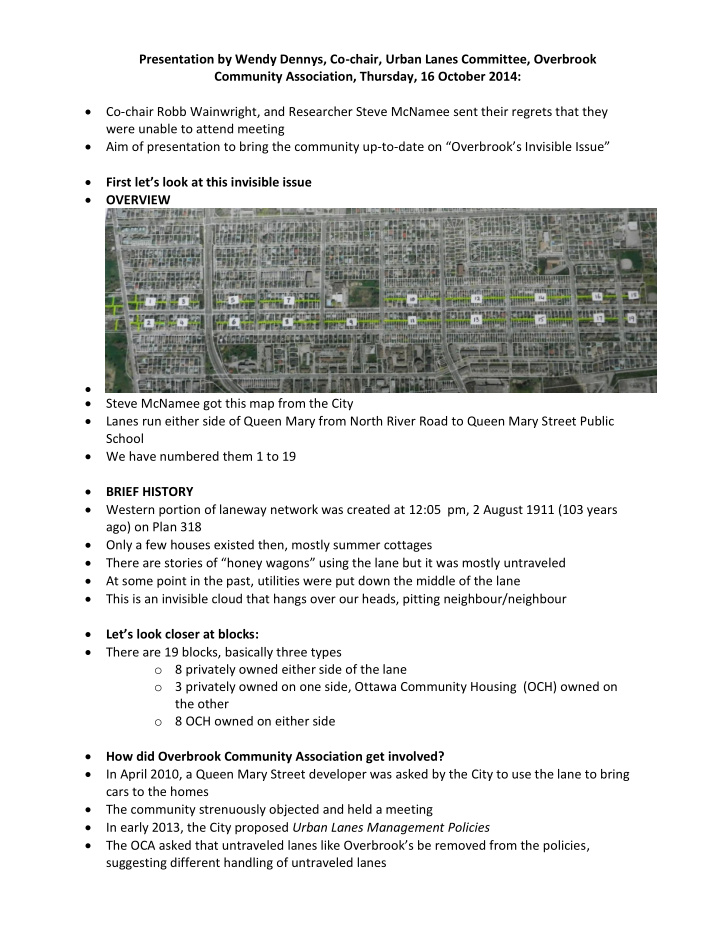



Presentation by Wendy Dennys, Co-chair, Urban Lanes Committee, Overbrook Community Association, Thursday, 16 October 2014: Co-chair Robb Wainwright, and Researcher Steve McNamee sent their regrets that they were unable to attend meeting Aim of presentation to bring the community up-to- date on “Overbrook’s Invisible Issue” First let’s look at this invisible issue OVERVIEW Steve McNamee got this map from the City Lanes run either side of Queen Mary from North River Road to Queen Mary Street Public School We have numbered them 1 to 19 BRIEF HISTORY Western portion of laneway network was created at 12:05 pm, 2 August 1911 (103 years ago) on Plan 318 Only a few houses existed then, mostly summer cottages There are stories of “ honey wagons ” using the lane but it was mostly untraveled At some point in the past, utilities were put down the middle of the lane This is an invisible cloud that hangs over our heads, pitting neighbour/neighbour Let’s look closer at blocks : There are 19 blocks, basically three types o 8 privately owned either side of the lane o 3 privately owned on one side, Ottawa Community Housing (OCH) owned on the other o 8 OCH owned on either side How did Overbrook Community Association get involved? In April 2010, a Queen Mary Street developer was asked by the City to use the lane to bring cars to the homes The community strenuously objected and held a meeting In early 2013, the City proposed Urban Lanes Management Policies The OCA asked that untraveled lanes like Overbrook’s be removed from the policies , suggesting different handling of untraveled lanes
In March 2013, City Council approved the new policies. In April 2013, OCA canvassed residents and set up a legal fund. In June 2013, the Urban Lanes ad hoc committee was formed formed In August 2013, a survey/questionnaire was delivered to 160 homes; 57 responded; 88% said they would buy land Therefore the mandate of the committee became: To pursue the closure of Overbrook’s lanes o as soon as possible o at minimum cost to homeowners What has Committee accomplished? Here was a watershed moment: “Overbrook’s Invisible Issue” became visible! What led up to this aha moment? With support from Councillor Clark, a pilot block was chosen In January 2014, he put a motion to Council to instruct staff to produce a report on a purchase price for pilot block In order to prepare the report, City required: o An application to close lane o An application fee of $4,657 (paid from Councillor’s discretionary fund) o Signatures of all homeowners on “petition of interest to purchase” o Sketch and photos of block This was submitted on 24 June 2014 After internal and external circulation of the application On Friday, 3 October 2014 The lane was officially closed! Now what? Closure of pilot block is the first step, purchase is next! We are waiting for the City’s report on the price Councillor contends land holds no value for City – we agree In London, ON, the city charged $1 for similar lane; In Hamilton, ON, $100 We suggest $100 be the limit. Then we negotiate the survey cost; we contend it’s City property, therefore they should pay.
There are many issues to be worked out – we need to stay steady and patient Purchase of the land on the pilot block has to be completed by 3 October 2015 or closure of the lane is nulled. Life after Pilot Block purchased? Recommend start preparation for 7 remaining Type 1 Blocks applications Applications will only be submitted once the pilot block lanes are purchased. Files have been prepared for each block, and block captains and helpers are sought. A meeting will be arranged to share the experienced gained through the pilot block closure process. Pilot Block experience: It takes time, patience and diplomacy to gather the signatures. Down the road? We need to research how to proceed with Type 2 blocks We need patience, one step at a time Be assured we will get there Reaching the end goal? Closure of Type 3 blocks City transfers land to OCH This move might be welcomed by both parties!
Recommend
More recommend